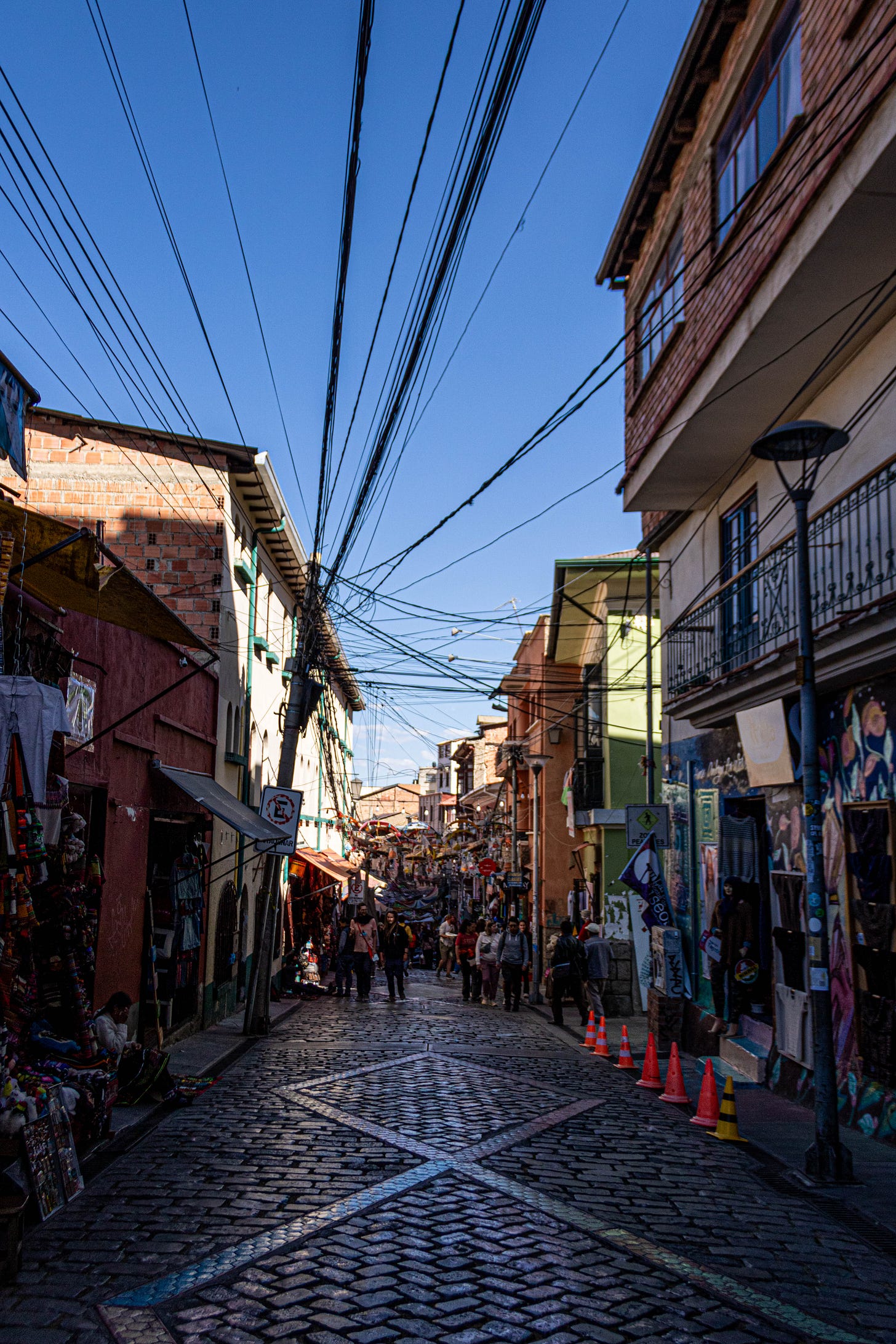From Copacabana on Titicaca Lake, Fernanda and I took a bus to La Paz, the ride was around 4 hours. We planned to pass by La Paz, but in the end, we decided to spend as much time as possible in this beautiful city. We spent there two days, one before and one after our tour to Uyuni, but it was enough to fall in love with it.
On our way to La Paz we had to pass the Tiquina Strait, a narrow passage of water that connects the larger and smaller parts of Lake Titicaca, known respectively as the Lago Mayor (Big Lake) and Lago Menor (Small Lake), in the Bolivia side.
The crossing of the Tiquina Strait is done by small ferry boats and barges. Vehicles, including buses and cars, are loaded onto these barges to be ferried across the strait, while passengers travel in separate smaller boats. The crossing takes only a few minutes but offers a scenic view of the lake and the surrounding area. The crossing was unforgettable, as it’s not every day you see a bus travelling alongside you on a barge! Who knows when I’ll witness something like that again!
La Paz is a fascinating city located in western Bolivia, known for its unique geography, rich cultural history, and vibrant urban life. It is one of the highest capital cities in the world, situated at an altitude of around 3,650 meters (11,975 feet) above sea level. This high elevation gives La Paz a dramatic setting, with the city sprawling in a deep valley surrounded by the towering peaks of the Andes Mountains, including the iconic Illimani, which looms over the city at 6,438 meters (21,122 feet).
As we arrived by bus, we were greeted by a breathtaking view of the valley and the city below. As we descended towards the bus station, the stunning scenery and the journey down made me fall in love with the city instantly, even before I set foot in it.
The city serves as the seat of the government and the executive capital of Bolivia, while Sucre remains the constitutional capital. This distinction makes La Paz a centre of political, economic, and cultural activity. The city's history is closely tied to Bolivia's colonial past and its indigenous heritage, evident in the blend of architectural styles, traditions, and languages spoken in the area.
La Paz is renowned for its bustling markets, such as the Witches Market (Mercado de las Brujas), where one can find a variety of traditional medicines, amulets, and offerings used in Andean spiritual practices. On the first night walking around after dinner, we finished randomly inside this market, at first I didn’t realize where I was, then Fernanda explained to me about this market and the offerings they were selling, even if she was aware of it from that moment she tried to voit it, because she could feel the strong energy coming from it. Something I liked was all the stalls on the streets of the city where ladies are selling anything, from food to sim cards, to phone accessories or souvenirs.
Another incredible thing is the public transportation in the city. The cable car system in La Paz, known as “Mi Teleférico”, is one of the most remarkable urban transportation systems in the world. Launched in 2014, this extensive network of cable cars has transformed how people navigate the steep and rugged terrain of La Paz and its neighbouring city, El Alto. It is the highest and longest urban cable car system globally, operating at altitudes ranging from 3,200 meters (10,500 feet) to over 4,000 meters (13,100 feet) above sea level.
Mi Teleférico was developed to address the transportation challenges posed by La Paz’s unique geography. The city's steep valleys and mountainous terrain made traditional forms of public transport, such as buses, both inefficient and time-consuming. The cable cars provide a solution that not only reduces commute times but also offers a safer and more environmentally friendly alternative.
The network currently consists of 10 lines, each identified by a different colour (e.g., Red, Yellow, Green, Blue). These lines span over 30 kilometres (about 19 miles) and include more than 30 stations. The cable cars operate smoothly over the city's varied topography, offering passengers breathtaking views of the surrounding mountains and urban landscape. We used the cable cars system twice, we did two loops transferring from one line to another, it was a great way to explore the city from the top, especially the second time when we did the ride in the evening and saw the city during the sunset and with all the lights on.
Beyond its functional role, Mi Teleférico has become a symbol of modernity and progress in Bolivia. Fernanda and I had the feeling of being in a futuristic city, like the one in the cartoon The Jetsons, I’m quite sure that it has also fostered a sense of pride among the residents, who can see the cable car system as a reflection of their city's unique character and innovation.
La Paz is also a gateway to many natural and cultural attractions in Bolivia, including the ancient ruins of Tiwanaku, or the surreal landscapes of the Uyuni Salt Flats, which we visited in a 3-day tour with many other amazing places like deserts, lagoons, geysers, but these are topics for the coming blogs.
See you soon,
Flavio






















La Paz looks fun. You see the contrast between modern (the Teliférico) and old (Witches Market). Thanks for the captivating photos!
Wow, another city that has masses of power lines stretching over the streets. Phuket used to be like that, but particularly in Phuket town they have now been out underground. So much safer. Such an interesting journey once again Flavio